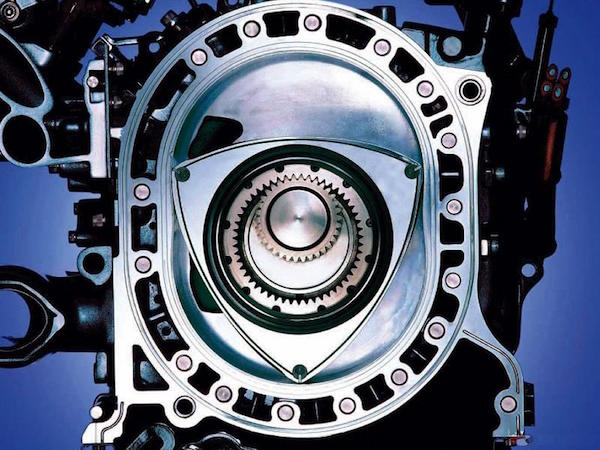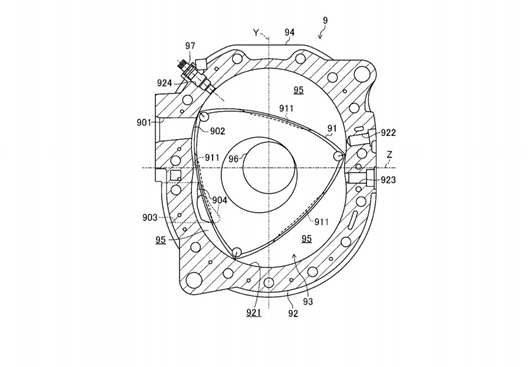『Rotary Engine』
2021-08-27

The engine that we often see in the form of piston reciprocating motion, that is, the piston makes a reciprocating linear motion in the cylinder, and the linear motion of the piston is converted into the rotation of the crankshaft through the crankshaft, while the rotary engine does not have this conversion process, it is through the piston The rotation in the cylinder drives the main shaft of the engine (that is, the crankshaft of an ordinary engine, because it is not curved, it is no longer called a crankshaft), so there is a big difference between the two.
A. Intake stroke: The process of piston movement from top dead center to bottom dead center is called intake stroke (crankshaft rotation angle 0~180°). In this stroke, the intake valve opens, the exhaust valve closes, and the air chamber communicates with the atmosphere. Atmospheric pressure makes the oil and gas mixture enter, and the pressure in the cylinder is about 0.075~0.09MPa at the end of the intake.
B.Compression stroke: The process of piston movement from bottom dead center to top dead center is called compression stroke (the crankshaft rotation angle is 180°~360°). In this stroke, the intake and exhaust valves are fully closed, and the oil and gas mixture pressure in the air chamber gradually increases. The pressure in the air chamber at the end of the compression stroke is about 0.6 to 1.2 MPa.
C.Power stroke: The process of piston movement from top dead center to bottom dead center is called power stroke (crankshaft rotation angle 360°~540°). In this stroke, the intake and exhaust valves are fully closed, and the spark plug jumps when the piston is at the top dead center position. The fire ignites the oil and gas mixture to make the pressure in the cylinder rise sharply (up to 3~5MPa), push the piston to move towards the crankshaft, the pressure gradually drops, and the pressure in the air chamber is about 0.3~0.5MPa at the end of the power stroke.
D.Exhaust stroke: The process of piston movement from bottom dead center to top dead center is called exhaust stroke (crankshaft rotation angle 540°~720°). In this stroke, the intake valve is closed, the exhaust valve is opened, and the piston moves upward to push the combustion. The exhaust gas is discharged from the air chamber, and the air pressure in the air chamber is about 0.105~0.115 MPa at the end of the stroke. The end of the stroke also marks the end of a working cycle of the engine.
The figure below shows the comparison of each stroke of a rotary engine and a reciprocating engine (the left side of the two air holes in the figure is the intake and the right side is the exhaust). The rotary engine is the same as the reciprocating four-stroke engine. Compression, work, and exhaust are composed of four strokes. The working cavity (BC working cavity) formed between a curved surface BC of the triangular rotor and the cylinder profile is taken as an example to illustrate the four-stroke working principle of a rotary engine.
Intake stroke: When the corner C of the triangular rotor turns to the right edge of the intake hole, the BC working chamber starts to intake air. At position a, the intake and exhaust holes are connected, and the intake and exhaust overlap. This is the smallest volume of the BC working chamber, which is equivalent to the top dead center position of the reciprocating engine. As the rotor continues to rotate, the volume of the BC working chamber gradually increases, and the combustible mixture is continuously sucked into the cylinder. When the rotor rotates 90° (the main shaft rotates 270°, the ratio of the rotor to the main shaft speed in the rotary engine is 1:3, which is determined by the meshing gears) reaches position b, the volume of the BC working chamber reaches the maximum, which is equivalent to the lower part of the reciprocating engine At the dead center position, the intake stroke ends.
Compression stroke: As the triangular rotor continues to rotate, the corner top B crosses the left edge of the inlet hole, and the compression stroke begins, the volume of the BC working chamber gradually decreases, and the pressure becomes larger and larger. When it reaches position c, the rotor rotates 180° (The main shaft rotates 540°), the BC working chamber volume reaches the minimum, which is equivalent to the top dead center position of the reciprocating engine, and the compression stroke ends.
Work stroke: At the end of the compression stroke, the spark plug flashes, the high temperature and high pressure gas pushes the triangular piston to continue to rotate, and the volume of the BC working chamber gradually increases. When the corner C reaches the right edge of the exhaust hole, at position d, the rotor rotates 270° (spindle rotation 810°), the volume of the BC working chamber reaches the maximum, which is equivalent to the bottom dead center position of the reciprocating engine, and the power stroke ends.
Exhaust stroke: when the triangle rotor angle C turns to the right side of the exhaust hole, the exhaust stroke starts, and finally the triangle rotor returns to position a, the exhaust stroke ends, the rotor rotates 360° (the main shaft rotates three times), and one work The cycle ends. At the same time, CA working cavity and AB working cavity also complete a working cycle respectively.
● Comparison of engine composition:
Rotary engine: body group, valve train, supply system, ignition system, cooling system, lubrication system, starting system
Reciprocating piston engine: body set, crank connecting rod mechanism, valve train, supply system, ignition system, cooling system, lubrication system, starting system
● The advantages and disadvantages of the two engines:
◆ Reciprocating engine:
advantage:
1. The manufacturing technology is mature. It has been born for more than 120 years. Various technologies have been continuously improved. It is the most widely used internal combustion engine in the world and has low maintenance and repair costs.
2. Reliable work, good air tightness and power transmission reliability.
3. Good fuel economy.
shortcoming:
1. Complex structure, large volume and heavy weight.
2. The reciprocating inertial force and moment of inertia caused by the reciprocating motion of the piston in the crank connecting rod mechanism cannot be completely balanced. The magnitude of this inertial force is proportional to the square of the speed, which reduces the smoothness of the engine running and restricts the development of high-speed engines.
3. As the working mode of the four-stroke reciprocating piston engine is that three of the four strokes completely rely on the flywheel inertia rotation, the power and torque output of the engine are very uneven, although modern engines use multi-cylinder and V-shaped arrangements. Reduce this shortcoming, but it is impossible to completely eliminate it.
◆ Rotary engine:
advantage:
1. Small size and light weight, easy to lower the center of gravity of the vehicle. Since the rotary engine does not have a crank connecting rod mechanism, the height of the engine is greatly reduced, and the center of gravity of the vehicle is lowered at the same time.
2. Simple structure. Compared with the reciprocating piston engine, the rotary engine reduces the crank connecting rod mechanism, which leads to a greatly simplified engine mechanism and fewer parts.
3. Uniform torque characteristics. Since one cylinder of a rotary engine has three working chambers at the same time, the torque output is more uniform than that of a reciprocating piston engine.
4. Conducive to the development of high-speed engines, because the piston rotor and main shaft speed ratio is 1:3, high piston speeds are not required to achieve high engine speeds.
shortcoming:
1. The fuel consumption is high, and the exhaust emission is difficult to meet the standard. Because each cylinder has three working chambers, each revolution of the piston rotor is equivalent to three power strokes. Compared with 3000rpm and reciprocating piston engine, the reciprocating piston engine sprays 750 times/min, and the rotary engine is equivalent to the speed of 1000rpm, but it needs 3000 times/min. It can be seen that the fuel consumption of the rotary engine is significantly higher than that of the reciprocating piston engine. At the same time, the shape of the combustion chamber of the rotary engine is not conducive to the full combustion of the combustible mixture, the flame propagation path is long, and the fuel oil consumption is large. At the same time, the pollutant content in the exhaust gas is higher.
2. Due to the structure of the engine, only the ignition type can be used instead of the compression ignition type, that is, only gasoline can be used as fuel instead of diesel.
3. Because the rotary engine uses an eccentric shaft, the engine vibrates greatly.
4. The high position of the power output shaft (spindle) is not conducive to the layout of the whole vehicle.
5. The processing and manufacturing technology of the rotary engine is high, and the cost is relatively high.




